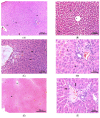Taurine Protects Doxorubicin-Induced Hepatotoxicity via Its Membrane-Stabilizing Effect in Rats
- PMID: 37895413
- PMCID: PMC10608465
- DOI: 10.3390/life13102031
Taurine Protects Doxorubicin-Induced Hepatotoxicity via Its Membrane-Stabilizing Effect in Rats
Abstract
Background: Doxorubicin (dox) is a chemotherapeutic agent widely used against various tumors. However, the clinical use of this agent is limited due to various organ toxicities. Taurine is an intracellular free β-amino acid with antioxidant properties. The present study investigated the protective mechanism of taurine on dox-induced hepatotoxicity.
Methods: In total, 31 male Sprague-Dawley rats were used in the study. The control group received intraperitoneal (i.p.) 0.9% NaCl alone for 14 days; the taurine (Tau) group received i.p. taurine 150 mg/kg body weight/day for 14 days; the dox group received dox on days 12, 13, and 14 at a cumulative dose of 25 mg/kg body weight/3 days; and the tau+dox group received taurine and dox together at the same dose and through the same route. On day 15, biochemical evaluations were performed on blood samples taken from the left ventricle followed by histological examinations on liver samples.
Results: Dox was found to increase liver function enzymes and tissue protein carbonyl levels, causing congestion and tissue damage, thereby leading to dysfunction. Tau was found to histologically preserve the liver morphology without showing any corrective effect on oxidative stress parameters. These findings suggest that the membrane-stabilizing effect of taurine may be more effective than its radical scavenging activity in preventing dox-induced toxicity.
Conclusion: Taurine can prevent doxorubicin-induced hepatotoxicity through non-antioxidant pathways.
Keywords: doxorubicin; hepatotoxicity; taurine.
Conflict of interest statement
The authors declare no conflict of interest. The authors have no relevant financial or non-financial interests to disclose. All of the authors declare that they have participated in the design, execution, and analysis of the manuscript and that they have approved the final version.
Figures



Similar articles
-
Protective effects of taurine on doxorubicin-induced acute hepatotoxicity through suppression of oxidative stress and apoptotic responses.Anticancer Drugs. 2016 Jan;27(1):17-23. doi: 10.1097/CAD.0000000000000299. Anticancer Drugs. 2016. PMID: 26426519
-
Protective effects of onion (Allium cepa) extract against doxorubicin-induced hepatotoxicity in rats.Toxicol Ind Health. 2016 Mar;32(3):551-7. doi: 10.1177/0748233713504807. Epub 2013 Nov 5. Toxicol Ind Health. 2016. PMID: 24193056
-
Protective effect of taurine against doxorubicin-induced cardiotoxicity in rats: echocardiographical and histological findings.Amino Acids. 2019 Nov;51(10-12):1649-1655. doi: 10.1007/s00726-019-02801-7. Epub 2019 Oct 31. Amino Acids. 2019. PMID: 31673792
-
Ameliorative Effect of Gallic Acid in Doxorubicin-Induced Hepatotoxicity in Wistar Rats Through Antioxidant Defense System.J Diet Suppl. 2018 Mar 4;15(2):183-196. doi: 10.1080/19390211.2017.1335822. Epub 2017 Jul 18. J Diet Suppl. 2018. PMID: 28718673
-
Preventive and therapeutic use of herbal compounds against doxorubicin induced hepatotoxicity: a comprehensive review.Naunyn Schmiedebergs Arch Pharmacol. 2023 Aug;396(8):1595-1617. doi: 10.1007/s00210-023-02429-1. Epub 2023 Mar 9. Naunyn Schmiedebergs Arch Pharmacol. 2023. PMID: 36892626 Review.
Cited by
-
Syringic Acid Alleviates Doxorubicin-Induced Hepatotoxicity Through PI3K/Akt-Mediated Nrf-2/HO-1 Signaling Pathways in Male Rats.Int J Mol Sci. 2025 Aug 12;26(16):7779. doi: 10.3390/ijms26167779. Int J Mol Sci. 2025. PMID: 40869100 Free PMC article.
-
Avenanthramide-C ameliorate doxorubicin-induced hepatotoxicity via modulating Akt/GSK-3β and Wnt-4/β-Catenin pathways in male rats.Front Mol Biosci. 2024 Dec 2;11:1507786. doi: 10.3389/fmolb.2024.1507786. eCollection 2024. Front Mol Biosci. 2024. PMID: 39687571 Free PMC article.
-
A narrative review and new insights into the protective effects of taurine against drug side effects.Naunyn Schmiedebergs Arch Pharmacol. 2025 Jan;398(1):203-230. doi: 10.1007/s00210-024-03331-0. Epub 2024 Aug 14. Naunyn Schmiedebergs Arch Pharmacol. 2025. PMID: 39141023 Review.
-
Gallic Acid and Taurine Attenuate Thiamethoxam-Induced Hepatotoxicity in Rats by Modulating SIRT-1/PGC-1α, NF-κB/iNOS, and p53/Bax/Caspase-3 Pathways.Pharmaceuticals (Basel). 2025 Jul 25;18(8):1112. doi: 10.3390/ph18081112. Pharmaceuticals (Basel). 2025. PMID: 40872506 Free PMC article.
References
-
- Shokrzadeh M., Bagheri A., Ghassemi-Barghi N., Rahmanian N., Eskandani M. Doxorubicin and doxorubicin-loaded nanoliposome induce senescence by enhancing oxidative stress, hepatotoxicity, and in vivo genotoxicity in male Wistar rats. Naunyn-Schmiedeberg’s Arch. Pharmacol. 2021;394:1803–1813. doi: 10.1007/s00210-021-02119-w. - DOI - PubMed
Grants and funding
LinkOut - more resources
Full Text Sources

